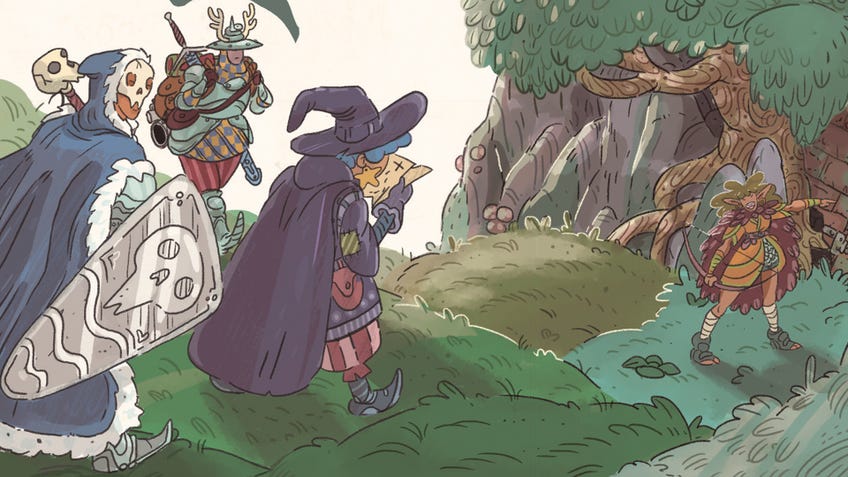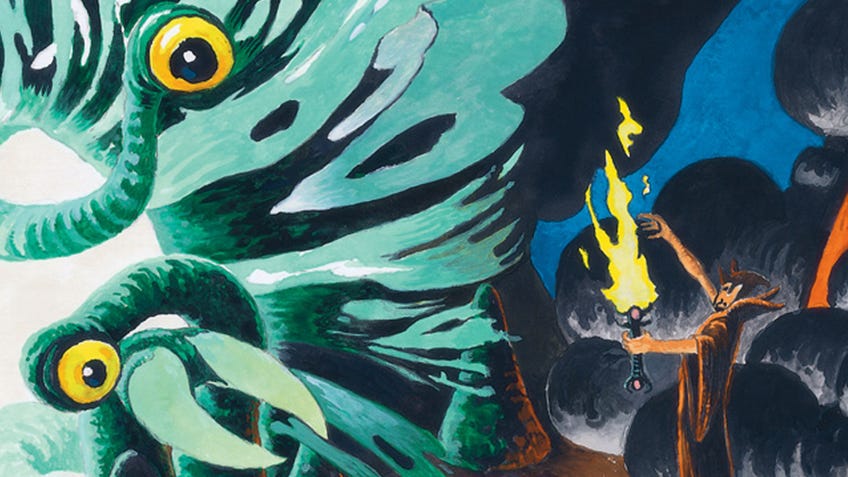Old-School Essentials is the perfect way to relive classic D&D roleplaying, whether you remember it or not
Back to Basic.
I’ve spent my weekend exploring the strangest, but most interesting dungeon I’ve ever encountered and being thrilled by combat in a way I haven’t for a long while. That is to say: I've been playing Old-School Essentials.
I love Dungeons and Dragons 5E; I play in multiple games a week and would never change that. So it was as much a surprise to me as anyone that I recently fell in love with what is effectively a clone of Dungeons & Dragons’ Basic/Expert sets, released in 1981. However, OSE has all the necessary updates to make it more easily digestible for playing today.
Old-School Essentials is one of the growing number of tabletop RPGs in the Old-School Revival movement (or Old-School Renaissance, depending on who you ask), harping back to the classic Dungeons & Dragons play style of old. OSE isn’t officially a D&D game itself - it just takes heavy inspiration from the rules and play of that era. It’s more of a love letter to the original game than one that tries to replicate it word-for-word.
It has less of a focus on stories and more on interacting with a world, generally through wilderness exploration and dungeons. It may not have the huge flexibility of something like 5E to take you from a wizard school in one session to a vampire's castle in the next, but if you’re hankering after a good ol’ fashioned expedition with the promise of live, laugh, loot - OSE does it best.
The first thing I’d recommend doing before playing, especially if you’ve only tried more modern fantasy RPGs, is to read something like the Old-School Primer by Matthew J. Finch or Principia Apocrypha by Ben Milton, Steven Lumpkin and David Perry. These give a great overview of how different something like OSE feels from modern games like 5E. More often than not when playing OSR RPGs, you’ll be unlearning habits you’ve picked up over years of play, rather than taking on tons of new rules.
The most obvious rule change, and the thing that really got me interested in the first place, are the combat rules. You’ll notice the character sheet is pretty basic; there aren’t any skills on there, and very few class features or racial bonuses. In Old-School Essentials, when you want to do something, you tell the DM exactly what you want to do - no feats necessary.
More often than not when playing OSR RPGs, you’ll be unlearning habits you’ve picked up over years of play, rather than taking on tons of new rules.
On your first-ever fight in a tabletop RPG did you try to stab a werewolf in the eye or cut a bandit’s sword arm off - anything to turn the fight in your favour - only to discover that you just do general damage to them and gradually need to wear down their HP to zero? Old-School Essentials is all about those kinds of fun and cinematic ideas. Maybe you did successfully cut the bandit’s sword hand off; outmanoeuvred, they flee the fight. Or perhaps use their less dominant hand to attack, becoming far less powerful. Maybe they just switch to bare-knuckle punches. The DM can have fun with outcomes the same way players can; you’re all deciding in the moment what cool thing might happen next.
That’s the same for anything you do. To check for traps you’ll be running hands over the stone floor, searching for loose flagstones and jamming an iron pick underneath one to hopefully disarm it. If you’re lying to a guard about where exactly you got that shiny new horse, you won’t roll deception - you’ve got to think of a convincing lie or, old faithful, point in one direction and ride off in another. Yes, I ended up in jail after that.

This all immerses you in the fantastical world that you’re inhabiting, but it definitely takes a while to get used to putting your character sheet aside and delving into your imagination instead. Old-School Essentials’ general rule for DMs and players is to go with what’s fun, so get creative. Use that slimy tree branch you picked up to knock out a kobold. Scatter jelly beans on the floor to trip up an ogre. Construct a rope out of vines to get across a pit in a dungeon.
While there are far fewer rules in some respects, because of the focus on exploration there are other additional rules for the process of getting around the sometimes hostile environment. Similar to a round of combat in D&D 5E, everything you do from your movement to actions happen within a limited amount of time. You can only walk so far in ten minutes, after all.
You might creep over to a bookcase, search its shelves for a trick book to trigger a secret door and watch as a panel in the wall slides open. That might be your whole turn. Then, the DM can roll to check if any wandering monsters heard the noise and head toward the party, or see how much of the players' torches burnt down, possibly leaving them in darkness. You are constantly tracking the passage of time when playing Old-School Essentials.
It sounds like a lot to handle at first. But similar to combat turns in 5E, it doesn’t take long to get into the swing of it. There are handy tables for keeping an eye on torches and rations - or maybe just be a dwarf and rely on Infravision to feel your way past enemies in the dark. No lizardmen are getting this stout little lady.

On the topic of rules, you might have heard of the dreaded THAC0, or will encounter it when opening up OSE’s Rules Tome (or the game's Basic Rules, which can be downloaded for free) for the first time. For those unfamiliar, “To Hit Armour Class 0" is a way of calculating if you can hit an enemy - and is regarded as overly-complex in many circles. You’re rolling to reach a zero point based on your hit dice, but then have to subtract a monster’s armour from your roll and use an attack matrix to check it all against - it’s easy to end up even more confused. Luckily, Old-School Essentials has taken all of that into account. For every monster stat block there are ascending armour class rules where the higher the number is, the harder it is to hit something. If a bugbear has an AC of 14, you have to roll that or above on your d20 to hit them. Simple. So don’t worry, you can disregard everything you just learnt and stick to the easy rules.
This is perhaps the most important point: Old-School Essentials and a lot of the retro remakes are not just out there to chase the nostalgia of people who played Dungeons & Dragons before the year 2000. Far from it. The Old-School Revival can seem intimidating, but I went into it looking for fun exploration and incredible dungeons. And that’s exactly what I got.
Old-School Essentials and a lot of the retro remakes are not just out there to chase the nostalgia of people who played Dungeons & Dragons before the year 2000.
As dungeons are the main draw for most adventuring parties, there are creative masterpieces out there that perfect the crawl. No boring traps, no endless rooms of monsters; instead, you can discover algae-coated remains of a lizard cult deep underground, overgrown gardens fallen into ruin or forgotten tombs that house restless fey deep within a magical forest. If I can feel like the Brothers Grimm puppeteering an evil tale while my players creep through a dungeon, I’m sold.
OSE is compatible with older adventures for D&D, so you can check out some amazing classics or easily adapt many of those that just aren’t as easy to experience in 5E. Of course, you can also build your own. There are tons of resources out there, as well as in the OSE Rules Tome itself.
Hopefully, you think you’re ready to go and play. You’ve got a basic idea of the difference in rules and how that feels while enjoying a game. Next, you need to get a group together! Old-School Essentials recommends groups of anywhere from six to eight characters, but you’re encouraged to also hire retainers - NPCs who act as grunts to back you up in combat, or go first in trap-infested dungeons. Just don’t tell them that’s the plan though. So if, like me, you struggle to get a big group together, you can still venture forth into Old-School Essentials.
It’s worth noting, though, that no matter how many people join you in an adventure, OSE isn’t set up to have perfectly balanced encounters you can always win. Monsters are dangerous, and fighting them head-on is rarely the best option. Trickery, stealth and cunning can be some of your best skills when facing a basilisk or owlbear. Try not to treat combat encounters in the same way you would in modern D&D. Plus, loot is where you get the most XP to level up anyway - so sneak past the ghouls and go for the gold!
Old-School Essentials is why my friends have heard nothing but “Enter the dungeon!” from me this past month. I’ve had a fantastic time playing and hope other people are encouraged to try it out, even if it’s not your typically favoured game. I never thought OSE would enter my favourites list, but here I am, trying to get everyone I can to have some old-school fantasy adventures.
Buy Old-School Essentials' Rules Tome from publisher Necrotic Gnome.


